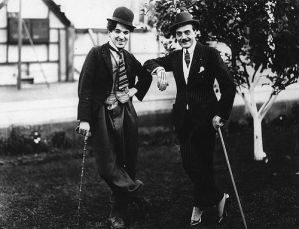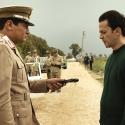The first cinema was two-thirds empty. A hundred seats had been laid out by the Lumière brothers in a Parisian salon, but only 33 of them were occupied. The small audience saw a film in which a crowd, mostly women in long dresses but also a large bounding dog, pour through a tall gate. None of them looks at the camera, as we would now. In 1895, stardom was not yet associated with film. The dog, as dogs will, gave much the most attention-seeking performance.
Paul Merton’s love for the faded movies of yesteryear is a matter of record. Previous documentaries on Buster Keaton, Harold Lloyd and the heroes of the silent age were part analysis, part love letter. Now he has stepped even further back in time to revisit the birth of cinema itself, and its nascent alliance with comedy. The story, entirely confined to Britain and France, found Merton on much safer ground than his recent rambles around Europe for Channel 5.
 The format was, at least in part, the same for his earlier homages. In a small cinema he showed clips to a live audience (of considerably more than 33), marvelling and, where appropriate, poking fun. We watched an early cinematic audience watching a silent, two-dimensional, black-and-white film of an oncoming train and reacting in horror. We may sneer now, but in fact they were already sneering within a few years of the birth of film. One early sequence showed a comedian in yokel dress standing in front of a screen, reacting in unsophisticated terror to the selfsame oncoming train.
The format was, at least in part, the same for his earlier homages. In a small cinema he showed clips to a live audience (of considerably more than 33), marvelling and, where appropriate, poking fun. We watched an early cinematic audience watching a silent, two-dimensional, black-and-white film of an oncoming train and reacting in horror. We may sneer now, but in fact they were already sneering within a few years of the birth of film. One early sequence showed a comedian in yokel dress standing in front of a screen, reacting in unsophisticated terror to the selfsame oncoming train.
The historical tour took us back to the race to capture the moving image. The zoetrope and the kinetoscope, the praxinoscope, bioscope and mutoscope all eventually gave precedence to the Lumières’ cinematoscope. Almost instantly, comedians were taking advantage of its coming. Not all the material filmed was up to much. Circus acts, vaudevillean dances, magical trompes l’oeil and crude comic set-ups were initially less wondrous than the fact of the technology itself.
Merton is always keen to doff a cap to British comedians, including here the stage hypnotist George Albert Smith and working-class comic Fred Evans, who in one film made hilarious fun of a surrendering Napoleon. But in the creation of silent film the French were not so easily defeated. Among the early geniuses to whom Merton paid tribute was Georges Méliès, creator of strange hand-coloured illusions. His fantastical image of the sun swallowing a train, or a rocket crashing into the moon, are vibrant precursors to the visual tropery we now think of as Pythonesque. There was a wonderful dog-chase sequence shot by rare female pioneer, Alice Guy. André Deed became the first star of silent comedy, brilliantly swallowing his clarinet in one captivating sequence of bravura surrealism.
Before the Great War, Deed would be surpassed only by the great Max Linder, who originated the sight gag of putting on a coat around a lamp post, subsequently purloined (and, it must be said, bettered) by Keaton. Ideas poured out of him and onto film - bouncing sets, dancing furniture, being stuck to cutlery and even to a lioness. He wrote them down on his shirtcuffs, explained his daughter. “He didn’t act,” she told Merton. “He just lived in front of the camera.”
The war killed off French dominance. Linder went to the trenches, was killed, then found to be alive. This miracle was trumpeted across the world. In 1917 he met Charlie Chaplin, who duly paid his respects (pictured above right). Linder may have recovered physically, but depression began to dog him until, despite the consolation of a young wife and child, he eventually killed himself. Other pioneering stars of the screen also fell from a great height. Deed returned to Pathé as a nightwatchman. His career over, Méliès ran a toyshop and, in a fit of despondency, destroyed most of his films.
You suspect that Merton is no fan of Hollywood muscle. He was eager to make the point here that, by the time the industry migrated west, the building blocks of cinematic grammar had already been established: the edit, the fade, the wipe, the double exposure. Too often, comedians are found fronting documentaries where they have no idea what they’re talking about. This was a delightful, moving tribute from a knowledgeable devotee.
- Watch Paul Merton's Weird and Wonderful World of Early Cinema on BBC iPlayer















Add comment